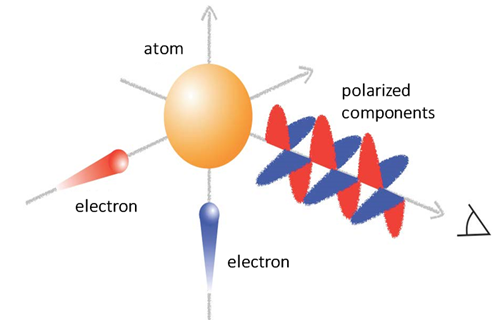HOME > Research Activities > Research Updates >
Polarization Spectroscopy Diagnostics
Large Helical Device plasma is confined using the magnetic field. Electrons in the plasma move around the magnetic field lines, and their trajectory follows a helical shape. This is because the electrons move freely in the direction of the magnetic field, however, they circulate in a plane perpendicular to the magnetic field. When an electromagnetic wave having the same frequency as that of the revolving electrons is injected into the plasma, the movement of electrons is accelerated and the velocity increases in the direction vertical to the magnetic field. On the other hand, the movement of the magnetic field’s direction is not affected. As a result, electrons come to have different velocities (that is, temperature) in perpendicular and parallel directions to the magnetic field. This type of temperature anisotropy is extremely important, because it influences the characteristics of the confinement of electrons in the magnetic field. At present, an effective diagnostics method to know the anisotropy has not yet been established.
A possible method for measuring the anisotropy of electron movement is in the light emitted by atoms or by ions in a plasma. When an atom collides with an electron, the atom absorbs a portion of the kinetic energy held by the electron and transits to a high-energy state. Because the high-energy state is unstable, as time passes (typically, in nanoseconds) the atom returns to the original low-energy state. At that time, the atom emits light corresponding to the difference of the energy state.
Light is one type of electromagnetic wave. The electromagnetic wave vibrates vertically to the direction in which the light (electromagnetic wave) is traveling. The vibration directions of the wave vary. In our daily lives, almost all of the light that we see contains various vibration-direction waves in an equal amount. However, at times, there also is light in which components of the specified vibration direction are significantly contained. That type of light is called “polarized light.”
The vibration direction of the light emitted from atoms collided with electrons is influenced by the direction of the movement of electrons. For that reason, when there is anisotropy in the movement of electrons, the light from the atoms too is polarized (Figure 1). In the LHD, we investigate the degree of the polarization of light that is emitted from a hydrogen atom, and are advancing in our research that seeks to understand the anisotropy of the movement of electrons in the plasma. Incorporating a special optical element that can pass the specific polarization component into a spectrometer, which is a device for measuring spectrum, we investigate in which direction oscillates the strongest polarization component. However, in LHD plasma the predicted amount of the polarization was small, and it was necessary to detect the difference in light strength at approximately one part per thousand (approximately 0.1%). Even though we understood the principle, it has been difficult to achieve high precision measurements to date.
A hint for overcoming those difficulties was found in our joint research with the Solar Science Observatory Group of the National Institutes of Natural Sciences National Astronomical Observatory of Japan. The sun’s atmosphere is in a plasma state, and the hydrogen atoms in the atmosphere absorb the light which the sun emits and transit to a high-energy state. The light which accompanies the back-transition becomes polarized because of the anisotropy of the sun’s radiated light. At the National Astronomical Observatory of Japan (NAOJ), researchers have developed high precision optical devices and are precisely measuring the polarized light emitted from solar plasma. At NIFS, we are, in particular, undertaking to establish a theoretical understanding of the polarization generation of light emitting atoms. The mechanisms by which LHD plasma and solar plasma generate polarized light differ, but the phenomena which humans see are similar. Further, regardless of whether LHD plasma or solar plasma, the plasma is composed primarily from hydrogen, and in the LHD it is comparatively easy to observe the emitted light from hydrogen atoms. While advancing with collaboration research, it is thought that the high precision optical devices developed at the NAOJ can be applied to polarized light measurement. And diagnostics devices have been developed over the past several years, and now in the LHD, too, high precision polarized light diagnostics have been achieved (Figure 2).
At present, we are developing calculation programs that are based upon theory, and from the magnitude of polarization that has been observed in the LHD we are moving forward with research that seeks to lead toward concrete conclusions regarding the anisotropy of electron movement.

Figure 1: A schematic diagram showing the principle by which an atom emits polarized light (emission line) in collisions with electrons. The emission lines from the collisions with the red and blue electrons are depicted in blue and red, respectively. Depending upon the direction of electron movement, the direction of the oscillations of light receives influence.

Figure 2: An example of the polarized light from hydrogen atom observed in the LHD. The upper image is the wavelength distribution (spectrum) of light emission intensity. The red lines and the blue lines have different light oscillation directions. In the lower image, the difference between the red lines and the blue lines is divided by their sum, and this is called the degree of polarization. We have learned that the degree of polarization is large in the central part of the spectrum.
